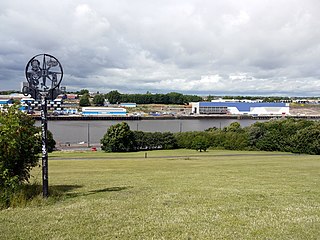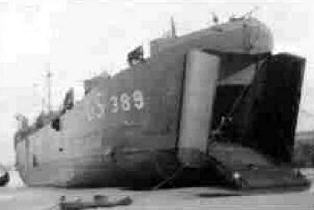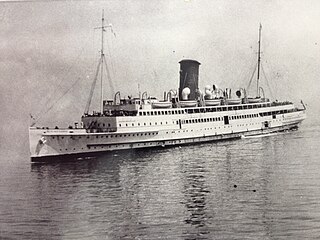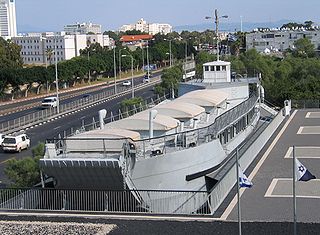
Landing craft are small and medium seagoing watercraft, such as boats and barges, used to convey a landing force from the sea to the shore during an amphibious assault. The term excludes landing ships, which are larger. Production of landing craft peaked during World War II, with a significant number of different designs produced in large quantities by the United Kingdom and United States.

The Landing Craft, Tank (LCT) was an amphibious assault craft for landing tanks on beachheads. They were initially developed by the Royal Navy and later by the United States Navy during World War II in a series of versions. Initially known as the "tank landing craft" (TLC) by the British, they later adopted the U.S. nomenclature "landing craft, tank" (LCT). The United States continued to build LCTs post-war, and used them under different designations in the Korean and Vietnam Wars.

Landing Ship, Tank (LST), or tank landing ship, is the naval designation for ships first developed during World War II (1939–1945) to support amphibious operations by carrying tanks, vehicles, cargo, and landing troops directly onto shore with no docks or piers. This enabled amphibious assaults on almost any beach.

The Great Float is a body of water on the Wirral Peninsula, England, formed from the natural tidal inlet, the Wallasey Pool. It is split into two large docks, East Float and West Float, both part of the Birkenhead Docks complex. The docks run approximately 2 miles (3 km) inland from the River Mersey, dividing the towns of Birkenhead and Wallasey. The Great Float consists of 110 acres (45 ha) of water and more than 4 miles (6 km) of quays.

HMS Bronington was a Ton-class minesweeper of the Royal Navy, launched on 19 March 1953. This mahogany-hulled minesweeper was one of the last of the "wooden walls".

The D-Day Story is a visitor attraction located in Southsea, Portsmouth in Hampshire, England. It tells the story of Operation Overlord during the Normandy D-Day landings. Originally opened as the D-Day Museum in 1984 by Queen Elizabeth The Queen Mother, it reopened as the D-Day Story, following a refurbishment funded by a £5 million Heritage Lottery grant, in March 2018. The museum building was designed by the then city architect Ken Norrish.

DD or Duplex Drive tanks, nicknamed "Donald Duck tanks", were a type of amphibious swimming tank developed by the British during the Second World War. The phrase is mostly used for the Duplex Drive variant of the M4 Sherman medium tank, that was used by the Western Allies during and after the Normandy Landings in June 1944.

HMS Forth, pennant number F04 later A187, was a submarine depot ship.

The Warship Preservation Trust was based in Birkenhead, Wirral, England and hosted Europe's largest collection of preserved warships.

Hebburn is a town in South Tyneside, Tyne and Wear, England. Hebburn is on the south bank of the River Tyne in North East England situated between the towns of Jarrow and Gateshead and to the south of Walker. The population of Hebburn was 18,808 in 2001, reducing to 16,492 at the 2011 Census for the two Hebburn Wards. Once part of the private Ellison estate, and made an independent Urban District in 1894, in 1974 it became part of the metropolitan county of Tyne and Wear. Hebburn lies within the historic boundaries of County Durham.

USS Benzie County (LST-266) was an LST-1-class tank landing ship built for the United States Navy during World War II. Named for Benzie County, Michigan, she was the only U.S. Naval vessel to bear the name.

USS Boone County (LST-389) was an LST-1-class tank landing ship built for the United States Navy during World War II. Named for counties in Arkansas, Illinois, Indiana, Iowa, Kentucky, Missouri, Nebraska, and West Virginia, she was the only U.S. Naval vessel to bear the name.

USS Phaon (ARB-3) was planned as a United States Navy LST-1-class tank landing ship, but was redesignated as one of twelve Aristaeus-class battle damage repair ships built for the United States Navy during World War II. Named for Phaon, she was the only US Naval vessel to bear the name.

The National Museum of the Royal Navy was created in early 2009 to act as a single non-departmental public body for the museums of the Royal Navy. With venues across the United Kingdom, the museums detail the history of the Royal Navy operating on and under the sea, on land and in the air.

USS Middlesex County (LST-983) was an LST-542-class tank landing ship built for the United States Navy during World War II. Named after counties in Connecticut, Massachusetts, New Jersey, and Virginia, she was the only U.S. Naval vessel to bear the name.

The Mark 8 Landing Craft Tank were landing craft tank ships operated by the British Armed Forces. The vessels were based on an American design, but improved into ocean-going vessels capable of sailing to and operating in the Far East.

An amphibious warfare ship is an amphibious vehicle warship employed to land and support ground forces, such as marines, on enemy territory during an amphibious assault.

TSS (RMS) Ben-my-Chree (IV) No. 145304 – the fourth vessel in the company's history to be so named – was a passenger ferry operated by the Isle of Man Steam Packet Company between 1927 and 1965.

USS LST-1008 was an LST-542-class tank landing ship in the United States Navy during World War II. She was transferred to the Republic of China Navy but then seized by Chinese communists and renamed Dabie Shan.

LCT 147 is an amphibious assault ship for landing tanks, other vehicles and troops on beachheads. Built in 1941 by Stockton Construction, Thornaby-on-Tees, the Mark 2 LCT 147 took part in the Invasion of North Africa in June 1943. The ship was converted to a Landing Craft Rocket at Portsmouth Dockyard from March through May 1943 and renamed LCT(2)(R) 147.





















